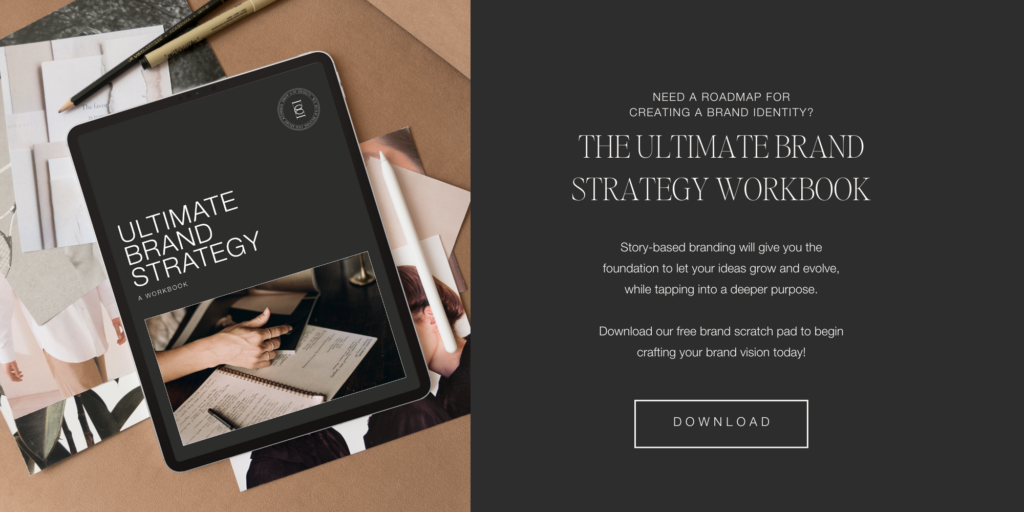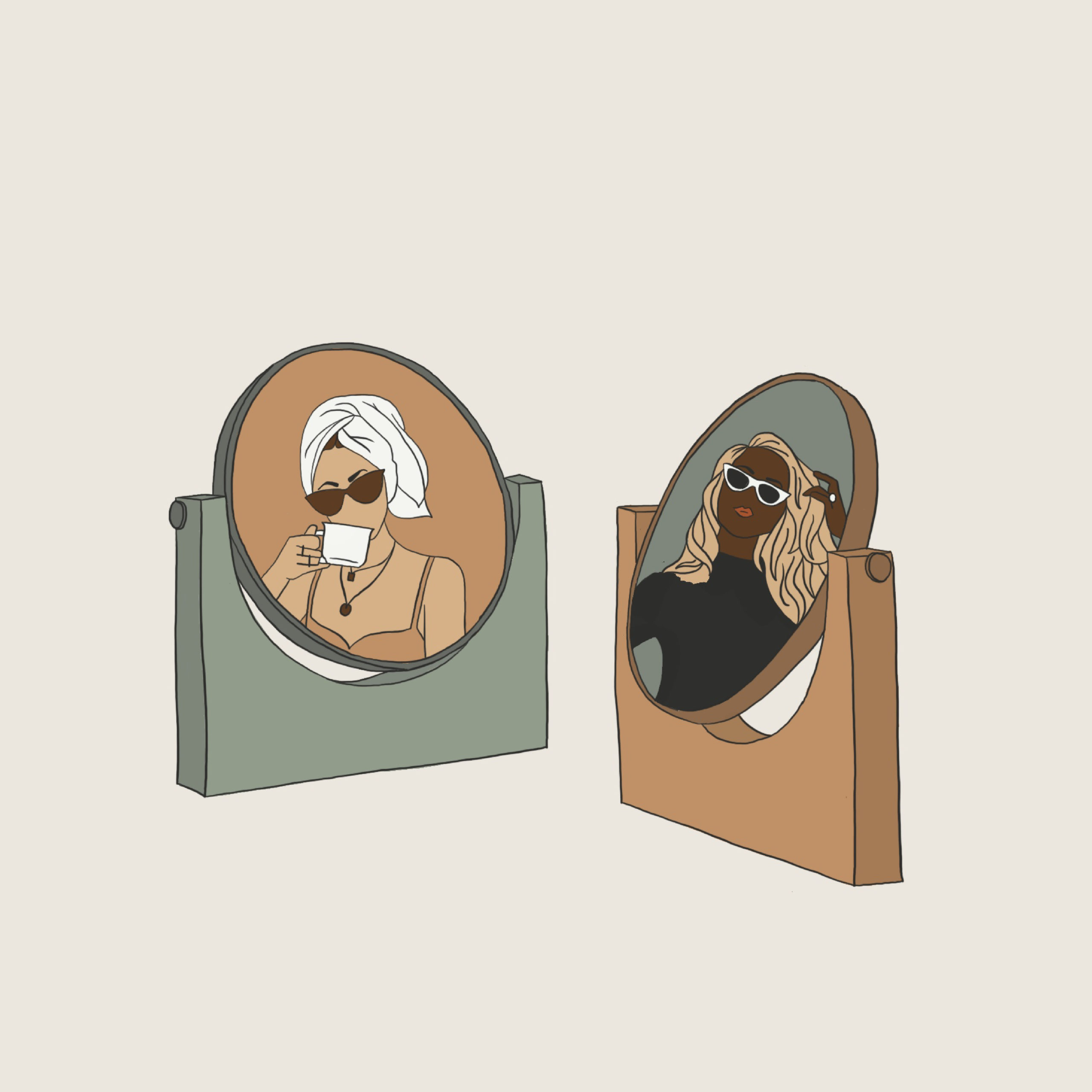“There’s nothing inherently refined about blending in.” -Hilary Rushford
These days, it seems like brand authenticity means blending into the “Authenticity Standard.” You know, that you work from home in yoga pants and a messy bun, drinking 18 cappuccinos every morning.
But… do you?
I know I don’t (I have two, ahem. And it’s black coffee.)
It can be so confusing to understand what makes a brand authentic when we’ve lost the meaning of the word. Let’s consider how to put your real self forward to an online audience.
This, too, can feel abstract.
It’s Subjective
Only you know when you’re being real, but we, the audience, pick up when something seems “off.”
It’s especially hard when you think your true self might not actually like people and prefers to be alone instead. So what the heck are you supposed to do with an audience of thousands when you can barely count your real-life friends on one hand?
Here are a few simple tricks to get you feeling like yourself and create the kind of interaction online that you actually enjoy, that feels authentic to you and YOUR brand.
Part One – The Texting Challenge
Commonly referred to as the “BFF Test,” this one exercise will take things a bit further.
My best friends and I don’t send emails unless they are links to concert tickets and those rarely come with much copy.
However.
Let my constant stream of group texts be a testament to the way I really communicate. Let it be a testament to my Real Housewives pop culture references and v trendy shorthand slang. When I’m writing on my phone, my genuine thoughts come out in perfect fluidity.
Raise your hand if you’ve sent the most emotionally insightful advice by typing it out on your phone. Raise your hand if you’ve commented on an Instagram post that left you giggling for an hour at your clever play on words. Raise your hand if the tone of your text has effectively communicated the urgency of your trash bag and laundry detergent situation.
Brand Authenticity from the Privacy of a Carpool Line
It seems that we’ve become more comfortable using language on our tiny screens than the Hemingway-esque image we have of lighting a candle, pouring a stiff drink, and hammering away at a masterpiece.
My writer boyfriend would kill me for suggesting anything otherwise, but if you’d rather not artistically struggle every time a blog post is set to go out or an email desperately needs to be written, I suggest you try typing it out. Let your thumbs hash out your shitty first draft.
I stumbled upon this idea with a former client, who wrote her entire website copy in her Notes app. I kid you not. I thought she was insane…. until I tried it. I tried writing out a newsletter sitting in my car at 2 pm in the afternoon outside my studio.
Notes from the Car, Novels from the Studio
I didn’t have a glass of wine, but instead a lukewarm coffee. Ariana Grande crooning from the car next door. A fly buzzing around my window.
But at that moment, I was completely in tune with my thoughts. And my words flowed in MY voice, the way I would actually say them to a friend.
Later that night I pulled out a long-stemmed wine glass. I lit an expensive candle and dimmed the lighting, pulling out that iPhone draft and sending it over to my computer.
I got myself into the mindset of a romantic writer and I edited. I softened areas and became more direct in others. Romantic language slowly developed, but I could not have added authenticity to my copy the way I did sitting in my car.
Feeling stuck in a sea of same? Try texting it out.
Part Two – Embracing Negativity
This one was inspired by a recent podcast on The Lively Show. In this episode, Jess comes to terms with her most recent feelings of negativity and misguided direction. She comes face to face with disappointment, failed expectations, and feelings of loneliness.
So weird that she feels that way because I only ever feel super happy and content and bursting with happiness over my perfectly curated life.
I mean who is this person who’s a creative entrepreneur and doesn’t feel like she could burst from all of the happiness and excitement at how easy life is? How dare she burst our bubble of positivity?
Being an Authentic Brand Aint Easy
A sure sign of an insincere brand is one that lacks the honesty that every entrepreneur faces on the journey to success. It’s a great way to lose personal relevance and start to blend in.
But this doesn’t mean creating sappy and depressing content that leaves everyone feeling depleted.
It’s about embracing negativity through the perspective of its eventual positive outcome. You don’t have to trade in your message of hope for one of despair, just be honest that hope doesn’t always look like a bright, sunshiny day.
Here are two great reasons why honest struggle impacts brand authenticity:
Negative experiences produce personal growth.
When you allow yourself to fully feel a negative emotion, it will allow you to grow and shift.
Just like the verse, “… but we also glory in our sufferings, because we know that suffering produces perseverance; perseverance, character; and character, hope.”
Character, integrity, goodness – those are things we each want to represent in our businesses, but they come from negative encounters that we turn into positive opportunities.
Negative feelings provide clarity.
Ever felt stuck or uninspired? Denying the negative influences in our lives can often leave us in a creative rut.
We have to radically honestly assess what makes us feel sad or lonely or even angry to find a way to gain clarity around what needs to change. Otherwise, you may stagnate if you never identify what you want and don’t want by way of a negative story.
When communicating these experiences in your business (especially if they mean changes in the way that your business runs) be honest about the process that led you to the decision.
If you’re going to take some time away from your business, don’t just disappear from your audience. Let them know you’re going to be away for a while, but that you’ll come back.
If you want to stop offering a service because it no longer brings you joy, communicate it to the people who are still asking about it. Give them an alternate solution.
The worst thing that you can do is operate from a place of silence when the answer discloses a bit of less-than-stellar information. It will leave the person who has so loyally followed and supported you feeling rejected. Brand authenticity means sharing what’s behind-the-screen.
Part Three – The Four Agreements
You can thank my yogi roommate Olivia for this one. Right in the middle of talking about comparison, she whips out the four agreements of her vinyasa flow class.
1. Be impeccable with your word.
2. Don’t take anything personally.
3. Don’t make assumptions.
4. Always do your best.
Because here’s the thing – stealing is heightened when it comes to copy. We’ve all seen it – the exact same affiliate marketing emails that bombard our inboxes, the shockingly similar blog posts or product descriptions, the social media captions that just do not reflect the author of the post.
When it comes to visual representation, we are appalled when artwork is stolen and rally together for proper credit. When it comes to copy? We are only slightly annoyed.
I think part of this is because we’ve all felt that feeling when we stare at a screen and try with all our might for the words to write themselves. Or wait for some bolt of inspiration to make our boring sentences pop from the page and beg to be read.
But remember…
Brand Authenticity on Social Media
Your journey, and your words, do not (and I repeat… do NOT) and should not and would not end up imitating those around you. Your story is YOURS.
Your business and your life are unfolding in exactly the way they were meant to in front of the audience you’re meant to lead. You are going to be FINE if you aren’t the first to use Beyonce’s latest song as a reference in your caption. You will be TOTALLY OK if someone else uses the “perfect tagline” in their bio before you.
Take a breath and take inventory of where you stand and why. Then and only then, write what’s really going on. I mean really. If we’re being honest, where are your true influences? Taking ownership over who you are will naturally cause your business to have brand authenticity.
Sharing the Real Story
Are your words coming from a deeply compelled heart or is it just an attempt to fit in? Because if you’re doing what everyone else is… well… you certainly won’t look like an idiot, honestly you won’t look like much. But don’t we want greatness? Don’t we want to move people? You can’t move anyone if you aren’t first moved yourself.
So when it comes to sharing your story – be impeccable, honest, and true with your words.
Don’t take anything personally. Hurting people hurt people, trolls are just robots with convincing profile pictures. Don’t make assumptions, because someone else’s highlight reel is not the full story. Everyone struggles.
Always do your best, that’s all anyone can ever ask of you.
These are the questions I use as a foundation in the branding process, sparking incredibly meaningful conversations. If you’re looking for a solid starting point to dive deeper, the Big Brand Workbook is a fantastic resource! I’d love to hear from you in the comments about which method you plan to try yourself!





First of all I would like to say fantastic blog! I had a quick question that I’d like to ask if
you do not mind. I was interested to find out how you center yourself and
clear your head before writing. I’ve had difficulty clearing my thoughts in getting my thoughts out.
I truly do take pleasure in writing but it just seems like the first 10 to 15 minutes are usually lost just trying to figure out how to begin. Any suggestions or hints?
Thanks!
Hey Josephine, thank you so much for your kind words! Writing can be tough; I know that feeling of staring at a blank screen and drawing a complete blank. I’ve found that finding quiet, undistracted time to sit in my thoughts helps. And you’re actually on the right path – I do a lot of freewriting to get the bad ideas out for 15-20 minutes before things really start to flow. Ann Lamott calls it the Sh*tty First Draft 🙂 I highly recommend reading her book Bird by Bird Hope this helps!